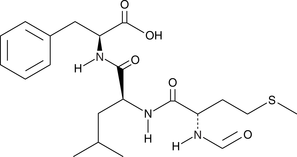Chemicals
Showing 28351–28500 of 41137 results
-
Several different arachidonoyl amino acid conjugates, including N-arachidonoyl dopamine and N-arachidonoyl-L-serine, have been isolated and characterized from bovine brain.{9589} N-Docosanoyl taurine is one of several novel taurine-conjugated fatty acids discovered during mass spectrometry lipidomic analysis of brain and spinal cord from wild-type and fatty acid amide hydrolase (FAAH) knockout mice.{13153} The levels of N-docosanoyl taurine were elevated ~12 fold in FAAH-/- mice compared to wild-type mice, indicating that FAAH utilizes N-docosanoyl taurine as a substrate. However, in vitro experiments with purified FAAH indicate that related N-fatty acyl taurines and ethanolamines of similar chain length are hydrolyzed 2,000-50,000 times more slowly by FAAH compared to oleoyl ethanolamide.{13153} N-acyl taurines bearing polyunsaturated acyl chains can activate members of the transient receptor potential (TRP) family of calcium channels, including TRPV1 and TRPV4.{16245}
Brand:CaymanSKU:10007288 - 1 mgAvailable on backorder
Several different arachidonoyl amino acid conjugates, including N-arachidonoyl dopamine and N-arachidonoyl-L-serine, have been isolated and characterized from bovine brain.{9589} N-Docosanoyl taurine is one of several novel taurine-conjugated fatty acids discovered during mass spectrometry lipidomic analysis of brain and spinal cord from wild-type and fatty acid amide hydrolase (FAAH) knockout mice.{13153} The levels of N-docosanoyl taurine were elevated ~12 fold in FAAH-/- mice compared to wild-type mice, indicating that FAAH utilizes N-docosanoyl taurine as a substrate. However, in vitro experiments with purified FAAH indicate that related N-fatty acyl taurines and ethanolamines of similar chain length are hydrolyzed 2,000-50,000 times more slowly by FAAH compared to oleoyl ethanolamide.{13153} N-acyl taurines bearing polyunsaturated acyl chains can activate members of the transient receptor potential (TRP) family of calcium channels, including TRPV1 and TRPV4.{16245}
Brand:CaymanSKU:10007288 - 10 mgAvailable on backorder
Several different arachidonoyl amino acid conjugates, including N-arachidonoyl dopamine and N-arachidonoyl-L-serine, have been isolated and characterized from bovine brain.{9589} N-Docosanoyl taurine is one of several novel taurine-conjugated fatty acids discovered during mass spectrometry lipidomic analysis of brain and spinal cord from wild-type and fatty acid amide hydrolase (FAAH) knockout mice.{13153} The levels of N-docosanoyl taurine were elevated ~12 fold in FAAH-/- mice compared to wild-type mice, indicating that FAAH utilizes N-docosanoyl taurine as a substrate. However, in vitro experiments with purified FAAH indicate that related N-fatty acyl taurines and ethanolamines of similar chain length are hydrolyzed 2,000-50,000 times more slowly by FAAH compared to oleoyl ethanolamide.{13153} N-acyl taurines bearing polyunsaturated acyl chains can activate members of the transient receptor potential (TRP) family of calcium channels, including TRPV1 and TRPV4.{16245}
Brand:CaymanSKU:10007288 - 5 mgAvailable on backorder
Quorum sensing is a regulatory system used by bacteria for controlling gene expression in response to increasing cell density. Controlling bacterial infections by quenching their quorum sensing systems is a promising field of study. The expression of specific target genes, such as transcriptional regulators belonging to the LuxR family of proteins, is coordinated by the synthesis of diffusible acylhomoserine lactone (AHL) molecules. N-dodecanoyl-L-Homoserine lactone (C12-HSL) is a small diffusible signaling molecule involved in quorum sensing, thereby controlling gene expression and affecting cellular metabolism in bacteria.{16305,16307,16308} In addition to regulating bacterial functions, C12-HSL activates NF-κB in RAW 264.7 macrophages, increasing the expression of TNF-α, interleukin-1β (IL-1β), and IL-8, while other lactones do not.{16593} In addition, C12-HSL alters cell cycling and metabolism of human keratinocyte (HaCaT) cells.{16591} It is important to note that C12-HSL is distinct from N-3-oxo-dodecanoyl-L-Homoserine lactone (Catalog No. 10007895), which is produced at different times in biofilm development{16592} and has different cellular effects.{16591}
Brand:CaymanSKU:10011203 - 10 mgAvailable on backorder
Quorum sensing is a regulatory system used by bacteria for controlling gene expression in response to increasing cell density. Controlling bacterial infections by quenching their quorum sensing systems is a promising field of study. The expression of specific target genes, such as transcriptional regulators belonging to the LuxR family of proteins, is coordinated by the synthesis of diffusible acylhomoserine lactone (AHL) molecules. N-dodecanoyl-L-Homoserine lactone (C12-HSL) is a small diffusible signaling molecule involved in quorum sensing, thereby controlling gene expression and affecting cellular metabolism in bacteria.{16305,16307,16308} In addition to regulating bacterial functions, C12-HSL activates NF-κB in RAW 264.7 macrophages, increasing the expression of TNF-α, interleukin-1β (IL-1β), and IL-8, while other lactones do not.{16593} In addition, C12-HSL alters cell cycling and metabolism of human keratinocyte (HaCaT) cells.{16591} It is important to note that C12-HSL is distinct from N-3-oxo-dodecanoyl-L-Homoserine lactone (Catalog No. 10007895), which is produced at different times in biofilm development{16592} and has different cellular effects.{16591}
Brand:CaymanSKU:10011203 - 25 mgAvailable on backorder
Quorum sensing is a regulatory system used by bacteria for controlling gene expression in response to increasing cell density. Controlling bacterial infections by quenching their quorum sensing systems is a promising field of study. The expression of specific target genes, such as transcriptional regulators belonging to the LuxR family of proteins, is coordinated by the synthesis of diffusible acylhomoserine lactone (AHL) molecules. N-dodecanoyl-L-Homoserine lactone (C12-HSL) is a small diffusible signaling molecule involved in quorum sensing, thereby controlling gene expression and affecting cellular metabolism in bacteria.{16305,16307,16308} In addition to regulating bacterial functions, C12-HSL activates NF-κB in RAW 264.7 macrophages, increasing the expression of TNF-α, interleukin-1β (IL-1β), and IL-8, while other lactones do not.{16593} In addition, C12-HSL alters cell cycling and metabolism of human keratinocyte (HaCaT) cells.{16591} It is important to note that C12-HSL is distinct from N-3-oxo-dodecanoyl-L-Homoserine lactone (Catalog No. 10007895), which is produced at different times in biofilm development{16592} and has different cellular effects.{16591}
Brand:CaymanSKU:10011203 - 5 mgAvailable on backorder
Quorum sensing is a regulatory system used by bacteria for controlling gene expression in response to increasing cell density. Controlling bacterial infections by quenching their quorum sensing systems is a promising field of study. The expression of specific target genes, such as transcriptional regulators belonging to the LuxR family of proteins, is coordinated by the synthesis of diffusible acylhomoserine lactone (AHL) molecules. N-dodecanoyl-L-Homoserine lactone (C12-HSL) is a small diffusible signaling molecule involved in quorum sensing, thereby controlling gene expression and affecting cellular metabolism in bacteria.{16305,16307,16308} In addition to regulating bacterial functions, C12-HSL activates NF-κB in RAW 264.7 macrophages, increasing the expression of TNF-α, interleukin-1β (IL-1β), and IL-8, while other lactones do not.{16593} In addition, C12-HSL alters cell cycling and metabolism of human keratinocyte (HaCaT) cells.{16591} It is important to note that C12-HSL is distinct from N-3-oxo-dodecanoyl-L-Homoserine lactone (Catalog No. 10007895), which is produced at different times in biofilm development{16592} and has different cellular effects.{16591}
Brand:CaymanSKU:10011203 - 50 mgAvailable on backorder
n-Dodecyl-α-D-maltoside is a nonionic detergent commonly used to solubilize integral membrane proteins and protein complexes.{46071,46072} It has a critical micelle concentration (CMC) of 0.15 mM.{46071} n-Dodecyl-α-D-maltoside has been used to solubilize photosystem I (PSI) and PSII complexes from plant thylakoid membranes, as well as intact grana.
Brand:CaymanSKU:26152 - 1 gAvailable on backorder
n-Dodecyl-α-D-maltoside is a nonionic detergent commonly used to solubilize integral membrane proteins and protein complexes.{46071,46072} It has a critical micelle concentration (CMC) of 0.15 mM.{46071} n-Dodecyl-α-D-maltoside has been used to solubilize photosystem I (PSI) and PSII complexes from plant thylakoid membranes, as well as intact grana.
Brand:CaymanSKU:26152 - 250 mgAvailable on backorder
n-Dodecyl-α-D-maltoside is a nonionic detergent commonly used to solubilize integral membrane proteins and protein complexes.{46071,46072} It has a critical micelle concentration (CMC) of 0.15 mM.{46071} n-Dodecyl-α-D-maltoside has been used to solubilize photosystem I (PSI) and PSII complexes from plant thylakoid membranes, as well as intact grana.
Brand:CaymanSKU:26152 - 500 mgAvailable on backorder
n-Dodecyl-β-D-maltoside (DDM) is a non-ionic detergent commonly used to solubilize membrane-associated proteins.{26985,26987} In particular, it helps retain the native conformation and activity of membrane-associated proteins, and facilitates the reforming of these proteins after denaturation.{26986,26990,26989} The critical micelle concentration of DDM is approximately 0.18 mM in water, decreases in the presence of sodium chloride or sucrose, and increases in urea.{26988}
Brand:CaymanSKU:-Out of stock
n-Dodecyl-β-D-maltoside (DDM) is a non-ionic detergent commonly used to solubilize membrane-associated proteins.{26985,26987} In particular, it helps retain the native conformation and activity of membrane-associated proteins, and facilitates the reforming of these proteins after denaturation.{26986,26990,26989} The critical micelle concentration of DDM is approximately 0.18 mM in water, decreases in the presence of sodium chloride or sucrose, and increases in urea.{26988}
Brand:CaymanSKU:-Out of stock
n-Dodecyl-β-D-maltoside (DDM) is a non-ionic detergent commonly used to solubilize membrane-associated proteins.{26985,26987} In particular, it helps retain the native conformation and activity of membrane-associated proteins, and facilitates the reforming of these proteins after denaturation.{26986,26990,26989} The critical micelle concentration of DDM is approximately 0.18 mM in water, decreases in the presence of sodium chloride or sucrose, and increases in urea.{26988}
Brand:CaymanSKU:-Out of stock
N-ethyl 2C-B (hydrochloride) (Item No. 29387) is an analytical reference standard categorized as a phenethylamine. N-ethyl 2C-B has hallucinogenic properties.{53666,53667} This product is intended for research and forensic applications.
Brand:CaymanSKU:29387 - 1 mgAvailable on backorder
N-ethyl 2C-B (hydrochloride) (Item No. 29387) is an analytical reference standard categorized as a phenethylamine. N-ethyl 2C-B has hallucinogenic properties.{53666,53667} This product is intended for research and forensic applications.
Brand:CaymanSKU:29387 - 5 mgAvailable on backorder
N-ethyl Hexylone (hydrochloride) (Item No. 25315) is an analytical reference standard categorized as a cathinone. This product is intended for research and forensic applications.
Brand:CaymanSKU:25315 - 1 mgAvailable on backorder
N-ethyl Hexylone (hydrochloride) (Item No. 25315) is an analytical reference standard categorized as a cathinone. This product is intended for research and forensic applications.
Brand:CaymanSKU:25315 - 5 mgAvailable on backorder
N-ethyl-3,4-DMA (hydrochloride) (Item No. 30482) is an analytical reference standard categorized as an amphetamine. This product is intended for research and forensic applications.
Brand:CaymanSKU:30482 - 1 mgAvailable on backorder
N-ethyl-3,4-DMA (hydrochloride) (Item No. 30482) is an analytical reference standard categorized as an amphetamine. This product is intended for research and forensic applications.
Brand:CaymanSKU:30482 - 5 mgAvailable on backorder
N-ethyl-4-Methoxyamphetamine (EMA) is an analog of 4-MA (Item No. 12041). The addition of an N-ethyl substituent decreases analgesic potency.{28076} Other physiological and toxicological properties of this compound are not known. This product is intended for forensic and research applications.
Brand:CaymanSKU:-Out of stock
N-ethyl-4-Methoxyamphetamine (EMA) is an analog of 4-MA (Item No. 12041). The addition of an N-ethyl substituent decreases analgesic potency.{28076} Other physiological and toxicological properties of this compound are not known. This product is intended for forensic and research applications.
Brand:CaymanSKU:-Out of stock
N-ethyl-4-Methoxyamphetamine (EMA) is an analog of 4-MA (Item No. 12041). The addition of an N-ethyl substituent decreases analgesic potency.{28076} Other physiological and toxicological properties of this compound are not known. This product is intended for forensic and research applications.
Brand:CaymanSKU:-Out of stock
N-Ethylamphetamine (EMA) is an N-substituted amphetamine with an ethyl group on the amphetamine backbone. As a stimulant drug of the phenethylamine and amphetamine chemical classes, it is widely known as an anorectic marketed under the tradename Apetinil™. N-Ethylamphetamine (EMA) is an N-substituted amphetamine with an ethyl group on the amphetamine backbone. As a stimulant drug of the phenethylamine and amphetamine chemical classes, it is widely known as an anorectic marketed under the tradename Apetinil™.{21432,21431} EMA has been abused as a “designer drug” alternative to amphetamine and possibly methamphetamine.{21432} This product is intended for forensic or research purposes.
Brand:CaymanSKU:-N-Formyl-Met-Leu-Phe (fMLF) is a synthetic peptide that acts as an agonist at formyl peptide receptors (FPRs; Ki = 0.8 pM), which are mainly localized on polymorphonuclear and mononuclear phagocytes.{34517} Activation of FPRs by fMLF leads to cellular activation, which is characterized by cellular polarization, chemotaxis, and release of proteolytic enzymes.{34518} fMLF induces contractions in isolated guinea pig jejunum (EC50 = 11 nM), proximal colon (EC50 = 3.5 nM), and distal colon (EC50 = 2.2 nM).{34516} In vitro, fMLF induces neurotransmitter release from enteric motor neurons.
Brand:CaymanSKU:21495 -Out of stock
N-Formyl-Met-Leu-Phe (fMLF) is a synthetic peptide that acts as an agonist at formyl peptide receptors (FPRs; Ki = 0.8 pM), which are mainly localized on polymorphonuclear and mononuclear phagocytes.{34517} Activation of FPRs by fMLF leads to cellular activation, which is characterized by cellular polarization, chemotaxis, and release of proteolytic enzymes.{34518} fMLF induces contractions in isolated guinea pig jejunum (EC50 = 11 nM), proximal colon (EC50 = 3.5 nM), and distal colon (EC50 = 2.2 nM).{34516} In vitro, fMLF induces neurotransmitter release from enteric motor neurons.
Brand:CaymanSKU:21495 -Out of stock
N-Formylmethamphetamine is an impurity generated in the synthesis of methamphetamine.{21545,21546} While suggested as being a route-specific impurity of the Leuckart method, this impurity has also been detected in methamphetamine samples produced from ephedrine or by reductive amination.{26120,26119} The physiological and toxicological properties of this compound are not known. This product is intended for forensic and research applications.
Brand:CaymanSKU:-N-Formylmethamphetamine is an impurity generated in the synthesis of methamphetamine.{21545,21546} While suggested as being a route-specific impurity of the Leuckart method, this impurity has also been detected in methamphetamine samples produced from ephedrine or by reductive amination.{26120,26119} The physiological and toxicological properties of this compound are not known. This product is intended for forensic and research applications.
Brand:CaymanSKU:-N-Formylmethamphetamine is an impurity generated in the synthesis of methamphetamine.{21545,21546} While suggested as being a route-specific impurity of the Leuckart method, this impurity has also been detected in methamphetamine samples produced from ephedrine or by reductive amination.{26120,26119} The physiological and toxicological properties of this compound are not known. This product is intended for forensic and research applications.
Brand:CaymanSKU:-N-Glycine globotriaosylsphingosine is a glycinated form of globotriaosylceramide (Item Nos. 24870 | 24871 | 24872) that contains a glycine residue in place of the fatty acyl group. It has been used as an internal standard for the quantification of lyso-globotriaosylceramide (Item No. 24873) in human plasma by UPLC-MS/MS.{41681} [Matreya, LLC. Catalog No. 1530]
Brand:CaymanSKU:24874 - 1 mgAvailable on backorder
N-Glycolylneuraminic acid (Neu5Gc) is a sialic acid that is found in non-human primate tissues.{46909,46910} It is not endogenously produced in humans due to a mutation in the gene that encodes CMP-Neu5Ac hydroxylase, the enzyme that hydrolyzes N-acetylneuraminic acid to form Neu5Gc, but accumulates in human cells after exogenous ingestion from dietary sources such as red meat and dairy products. Neu5Gc accumulates in human tumors, including retinoblastomas, melanomas, colon carcinomas, and breast cancer, and Neu5Gc uptake is enhanced under hypoxic conditions.{46910}
Brand:CaymanSKU:30283 - 10 mgAvailable on backorder
N-Glycolylneuraminic acid (Neu5Gc) is a sialic acid that is found in non-human primate tissues.{46909,46910} It is not endogenously produced in humans due to a mutation in the gene that encodes CMP-Neu5Ac hydroxylase, the enzyme that hydrolyzes N-acetylneuraminic acid to form Neu5Gc, but accumulates in human cells after exogenous ingestion from dietary sources such as red meat and dairy products. Neu5Gc accumulates in human tumors, including retinoblastomas, melanomas, colon carcinomas, and breast cancer, and Neu5Gc uptake is enhanced under hypoxic conditions.{46910}
Brand:CaymanSKU:30283 - 100 mgAvailable on backorder
N-Glycolylneuraminic acid (Neu5Gc) is a sialic acid that is found in non-human primate tissues.{46909,46910} It is not endogenously produced in humans due to a mutation in the gene that encodes CMP-Neu5Ac hydroxylase, the enzyme that hydrolyzes N-acetylneuraminic acid to form Neu5Gc, but accumulates in human cells after exogenous ingestion from dietary sources such as red meat and dairy products. Neu5Gc accumulates in human tumors, including retinoblastomas, melanomas, colon carcinomas, and breast cancer, and Neu5Gc uptake is enhanced under hypoxic conditions.{46910}
Brand:CaymanSKU:30283 - 250 mgAvailable on backorder
N-Glycolylneuraminic acid (Neu5Gc) is a sialic acid that is found in non-human primate tissues.{46909,46910} It is not endogenously produced in humans due to a mutation in the gene that encodes CMP-Neu5Ac hydroxylase, the enzyme that hydrolyzes N-acetylneuraminic acid to form Neu5Gc, but accumulates in human cells after exogenous ingestion from dietary sources such as red meat and dairy products. Neu5Gc accumulates in human tumors, including retinoblastomas, melanomas, colon carcinomas, and breast cancer, and Neu5Gc uptake is enhanced under hypoxic conditions.{46910}
Brand:CaymanSKU:30283 - 50 mgAvailable on backorder
Quorum sensing is a regulatory system used by bacteria for controlling gene expression in response to increasing cell density. Controlling bacterial infections by quenching their quorum sensing systems is involved in a promising field of study. The expression of specific target genes, such as transcriptional regulators belonging to the LuxIR family of proteins, is coordinated by synthesis of diffusible acylhomoserine lactone (AHL) molecules. N-heptanoyl-L-Homoserine lactone (C7-HSL) is a small diffusible signaling molecule involved in quorum sensing, thereby controlling gene expression and affecting cellular metabolism.{16307,16304} The diverse applications of this molecule include regulation of virulence, infection prevention, and septicemia in fish.{14089}
Brand:CaymanSKU:10011198 - 10 mgAvailable on backorder
Quorum sensing is a regulatory system used by bacteria for controlling gene expression in response to increasing cell density. Controlling bacterial infections by quenching their quorum sensing systems is involved in a promising field of study. The expression of specific target genes, such as transcriptional regulators belonging to the LuxIR family of proteins, is coordinated by synthesis of diffusible acylhomoserine lactone (AHL) molecules. N-heptanoyl-L-Homoserine lactone (C7-HSL) is a small diffusible signaling molecule involved in quorum sensing, thereby controlling gene expression and affecting cellular metabolism.{16307,16304} The diverse applications of this molecule include regulation of virulence, infection prevention, and septicemia in fish.{14089}
Brand:CaymanSKU:10011198 - 25 mgAvailable on backorder
Quorum sensing is a regulatory system used by bacteria for controlling gene expression in response to increasing cell density. Controlling bacterial infections by quenching their quorum sensing systems is involved in a promising field of study. The expression of specific target genes, such as transcriptional regulators belonging to the LuxIR family of proteins, is coordinated by synthesis of diffusible acylhomoserine lactone (AHL) molecules. N-heptanoyl-L-Homoserine lactone (C7-HSL) is a small diffusible signaling molecule involved in quorum sensing, thereby controlling gene expression and affecting cellular metabolism.{16307,16304} The diverse applications of this molecule include regulation of virulence, infection prevention, and septicemia in fish.{14089}
Brand:CaymanSKU:10011198 - 5 mgAvailable on backorder
Quorum sensing is a regulatory system used by bacteria for controlling gene expression in response to increasing cell density. Controlling bacterial infections by quenching their quorum sensing systems is involved in a promising field of study. The expression of specific target genes, such as transcriptional regulators belonging to the LuxIR family of proteins, is coordinated by synthesis of diffusible acylhomoserine lactone (AHL) molecules. N-heptanoyl-L-Homoserine lactone (C7-HSL) is a small diffusible signaling molecule involved in quorum sensing, thereby controlling gene expression and affecting cellular metabolism.{16307,16304} The diverse applications of this molecule include regulation of virulence, infection prevention, and septicemia in fish.{14089}
Brand:CaymanSKU:10011198 - 50 mgAvailable on backorder
Quorum sensing is a regulatory system used by bacteria for controlling gene expression in response to increasing cell density.{15370} This regulatory process manifests itself with a variety of phenotypes including biofilm formation and virulence factor production.{13434} Coordinated gene expression is achieved by the production, release, and detection of small diffusible signal molecules called autoinducers. The N-acylated homoserine lactones (AHLs) comprise one such class of autoinducers, each of which generally consists of a fatty acid coupled with homoserine lactone (HSL). Regulation of bacterial quorum sensing signaling systems to inhibit pathogenesis represents a new approach to antimicrobial therapy in the treatment of infectious diseases.{15369} AHLs vary in acyl group length (C4-C18), in the substitution of C3 (hydrogen, hydroxyl, or oxo group), and in the presence or absence of one or more carbon-carbon double bonds in the fatty acid chain. These differences confer signal specificity through the affinity of transcriptional regulators of the LuxR family.{15398} C16-HSL is one of a number of lipophilic, long acyl side-chain bearing AHLs, including its monounsaturated analog C16:1-(L)-HSL, produced by the LuxI AHL synthase homolog SinI involved in quorum-sensing signaling in S. meliloti, a nitrogen-fixing bacterial symbiont of certain legumes.{15834,15835} C16-HSL is the most abundant AHL produced by the proteobacterium R. capsulatus and activates genetic exchange between R. capsulatus cells.{16891} N-Hexadecanoyl-L-homoserine lactone and other hydrophobic AHLs tend to localize in relatively lipophilic cellular environments of bacteria and cannot diffuse freely through the cell membrane. The long-chain N-acylhomoserine lactones may be exported from cells by efflux pumps or may be transported between communicating cells by way of extracellular outer membrane vesicles.{16892,16832}
Brand:CaymanSKU:-Quorum sensing is a regulatory system used by bacteria for controlling gene expression in response to increasing cell density.{15370} This regulatory process manifests itself with a variety of phenotypes including biofilm formation and virulence factor production.{13434} Coordinated gene expression is achieved by the production, release, and detection of small diffusible signal molecules called autoinducers. The N-acylated homoserine lactones (AHLs) comprise one such class of autoinducers, each of which generally consists of a fatty acid coupled with homoserine lactone (HSL). Regulation of bacterial quorum sensing signaling systems to inhibit pathogenesis represents a new approach to antimicrobial therapy in the treatment of infectious diseases.{15369} AHLs vary in acyl group length (C4-C18), in the substitution of C3 (hydrogen, hydroxyl, or oxo group), and in the presence or absence of one or more carbon-carbon double bonds in the fatty acid chain. These differences confer signal specificity through the affinity of transcriptional regulators of the LuxR family.{15398} C16-HSL is one of a number of lipophilic, long acyl side-chain bearing AHLs, including its monounsaturated analog C16:1-(L)-HSL, produced by the LuxI AHL synthase homolog SinI involved in quorum-sensing signaling in S. meliloti, a nitrogen-fixing bacterial symbiont of certain legumes.{15834,15835} C16-HSL is the most abundant AHL produced by the proteobacterium R. capsulatus and activates genetic exchange between R. capsulatus cells.{16891} N-Hexadecanoyl-L-homoserine lactone and other hydrophobic AHLs tend to localize in relatively lipophilic cellular environments of bacteria and cannot diffuse freely through the cell membrane. The long-chain N-acylhomoserine lactones may be exported from cells by efflux pumps or may be transported between communicating cells by way of extracellular outer membrane vesicles.{16892,16832}
Brand:CaymanSKU:-Quorum sensing is a regulatory system used by bacteria for controlling gene expression in response to increasing cell density.{15370} This regulatory process manifests itself with a variety of phenotypes including biofilm formation and virulence factor production.{13434} Coordinated gene expression is achieved by the production, release, and detection of small diffusible signal molecules called autoinducers. The N-acylated homoserine lactones (AHLs) comprise one such class of autoinducers, each of which generally consists of a fatty acid coupled with homoserine lactone (HSL). Regulation of bacterial quorum sensing signaling systems to inhibit pathogenesis represents a new approach to antimicrobial therapy in the treatment of infectious diseases.{15369} AHLs vary in acyl group length (C4-C18), in the substitution of C3 (hydrogen, hydroxyl, or oxo group), and in the presence or absence of one or more carbon-carbon double bonds in the fatty acid chain. These differences confer signal specificity through the affinity of transcriptional regulators of the LuxR family.{15398} C16-HSL is one of a number of lipophilic, long acyl side-chain bearing AHLs, including its monounsaturated analog C16:1-(L)-HSL, produced by the LuxI AHL synthase homolog SinI involved in quorum-sensing signaling in S. meliloti, a nitrogen-fixing bacterial symbiont of certain legumes.{15834,15835} C16-HSL is the most abundant AHL produced by the proteobacterium R. capsulatus and activates genetic exchange between R. capsulatus cells.{16891} N-Hexadecanoyl-L-homoserine lactone and other hydrophobic AHLs tend to localize in relatively lipophilic cellular environments of bacteria and cannot diffuse freely through the cell membrane. The long-chain N-acylhomoserine lactones may be exported from cells by efflux pumps or may be transported between communicating cells by way of extracellular outer membrane vesicles.{16892,16832}
Brand:CaymanSKU:-Quorum sensing is a regulatory system used by bacteria for controlling gene expression in response to increasing cell density.{15370} This regulatory process manifests itself with a variety of phenotypes including biofilm formation and virulence factor production.{13434} Coordinated gene expression is achieved by the production, release, and detection of small diffusible signal molecules called autoinducers. The N-acylated homoserine lactones (AHLs) comprise one such class of autoinducers, each of which generally consists of a fatty acid coupled with homoserine lactone (HSL). Regulation of bacterial quorum sensing signaling systems to inhibit pathogenesis represents a new approach to antimicrobial therapy in the treatment of infectious diseases.{15369} AHLs vary in acyl group length (C4-C18), in the substitution of C3 (hydrogen, hydroxyl, or oxo group), and in the presence or absence of one or more carbon-carbon double bonds in the fatty acid chain. These differences confer signal specificity through the affinity of transcriptional regulators of the LuxR family.{15398} C16-HSL is one of a number of lipophilic, long acyl side-chain bearing AHLs, including its monounsaturated analog C16:1-(L)-HSL, produced by the LuxI AHL synthase homolog SinI involved in quorum-sensing signaling in S. meliloti, a nitrogen-fixing bacterial symbiont of certain legumes.{15834,15835} C16-HSL is the most abundant AHL produced by the proteobacterium R. capsulatus and activates genetic exchange between R. capsulatus cells.{16891} N-Hexadecanoyl-L-homoserine lactone and other hydrophobic AHLs tend to localize in relatively lipophilic cellular environments of bacteria and cannot diffuse freely through the cell membrane. The long-chain N-acylhomoserine lactones may be exported from cells by efflux pumps or may be transported between communicating cells by way of extracellular outer membrane vesicles.{16892,16832}
Brand:CaymanSKU:-N-hexanoyl-DL-Homoserine lactone is a bacterial quorum sensing signaling molecule that is produced by mammalian pathogenic and rhizosphere-colonizing bacteria.{54113,54114,54115} Application of N-hexanoyl-DL-homoserine lactone (60 µM) to tomato leaves suppresses the development of lesions induced by the plant pathogenic fungi B. cinerea.{54114} It also increases root length and shoot diameter when applied to A. thaliana seedlings in a hydroponic growth system at a concentration of 10 µM.{54115}
Brand:CaymanSKU:10011197 - 10 mgAvailable on backorder
N-hexanoyl-DL-Homoserine lactone is a bacterial quorum sensing signaling molecule that is produced by mammalian pathogenic and rhizosphere-colonizing bacteria.{54113,54114,54115} Application of N-hexanoyl-DL-homoserine lactone (60 µM) to tomato leaves suppresses the development of lesions induced by the plant pathogenic fungi B. cinerea.{54114} It also increases root length and shoot diameter when applied to A. thaliana seedlings in a hydroponic growth system at a concentration of 10 µM.{54115}
Brand:CaymanSKU:10011197 - 25 mgAvailable on backorder
N-hexanoyl-DL-Homoserine lactone is a bacterial quorum sensing signaling molecule that is produced by mammalian pathogenic and rhizosphere-colonizing bacteria.{54113,54114,54115} Application of N-hexanoyl-DL-homoserine lactone (60 µM) to tomato leaves suppresses the development of lesions induced by the plant pathogenic fungi B. cinerea.{54114} It also increases root length and shoot diameter when applied to A. thaliana seedlings in a hydroponic growth system at a concentration of 10 µM.{54115}
Brand:CaymanSKU:10011197 - 5 mgAvailable on backorder
Quorum sensing is a regulatory system used by bacteria for controlling gene expression in response to increasing cell density. A promising field of study involves controlling bacterial infections by quenching their quorum sensing systems. The expression of specific target genes, such as transcriptional regulators belonging to the LuxIR family of proteins, is coordinated by synthesis of diffusible acylhomoserine lactone (AHL) molecules. N-hexanoyl-L-Homoserine lactone is a small diffusible signaling molecule involved in quorum sensing, controlling gene expression, and affecting cellular metabolism.{13434} The diverse applications of this molecule include regulation of virulence in general and in cystic fibrosis, infection prevention, slime and biofilm reduction in commercial agriculture and aquaculture industries, food spoilage prevention, and septicemia in fish.{14089,14090,14091,14092,14093,14094,14095}
Brand:CaymanSKU:10007896 - 10 mgAvailable on backorder
Quorum sensing is a regulatory system used by bacteria for controlling gene expression in response to increasing cell density. A promising field of study involves controlling bacterial infections by quenching their quorum sensing systems. The expression of specific target genes, such as transcriptional regulators belonging to the LuxIR family of proteins, is coordinated by synthesis of diffusible acylhomoserine lactone (AHL) molecules. N-hexanoyl-L-Homoserine lactone is a small diffusible signaling molecule involved in quorum sensing, controlling gene expression, and affecting cellular metabolism.{13434} The diverse applications of this molecule include regulation of virulence in general and in cystic fibrosis, infection prevention, slime and biofilm reduction in commercial agriculture and aquaculture industries, food spoilage prevention, and septicemia in fish.{14089,14090,14091,14092,14093,14094,14095}
Brand:CaymanSKU:10007896 - 25 mgAvailable on backorder
Quorum sensing is a regulatory system used by bacteria for controlling gene expression in response to increasing cell density. A promising field of study involves controlling bacterial infections by quenching their quorum sensing systems. The expression of specific target genes, such as transcriptional regulators belonging to the LuxIR family of proteins, is coordinated by synthesis of diffusible acylhomoserine lactone (AHL) molecules. N-hexanoyl-L-Homoserine lactone is a small diffusible signaling molecule involved in quorum sensing, controlling gene expression, and affecting cellular metabolism.{13434} The diverse applications of this molecule include regulation of virulence in general and in cystic fibrosis, infection prevention, slime and biofilm reduction in commercial agriculture and aquaculture industries, food spoilage prevention, and septicemia in fish.{14089,14090,14091,14092,14093,14094,14095}
Brand:CaymanSKU:10007896 - 5 mgAvailable on backorder
Quorum sensing is a regulatory system used by bacteria for controlling gene expression in response to increasing cell density. A promising field of study involves controlling bacterial infections by quenching their quorum sensing systems. The expression of specific target genes, such as transcriptional regulators belonging to the LuxIR family of proteins, is coordinated by synthesis of diffusible acylhomoserine lactone (AHL) molecules. N-hexanoyl-L-Homoserine lactone is a small diffusible signaling molecule involved in quorum sensing, controlling gene expression, and affecting cellular metabolism.{13434} The diverse applications of this molecule include regulation of virulence in general and in cystic fibrosis, infection prevention, slime and biofilm reduction in commercial agriculture and aquaculture industries, food spoilage prevention, and septicemia in fish.{14089,14090,14091,14092,14093,14094,14095}
Brand:CaymanSKU:10007896 - 50 mgAvailable on backorder
N-Hippuryl-His-Leu (hydrate) is a synthetic substrate for angiotensin-converting enzyme (ACE) that has been used in the in vitro identification of ACE inhibitors.{37236},{37237}
Brand:CaymanSKU:23329 - 25 mgAvailable on backorder
N-Hippuryl-His-Leu (hydrate) is a synthetic substrate for angiotensin-converting enzyme (ACE) that has been used in the in vitro identification of ACE inhibitors.{37236},{37237}
Brand:CaymanSKU:23329 - 50 mgAvailable on backorder
3,4-Methylenedioxyamphetamine (MDA) is psychedelic and entactogenic drug that is scheduled as a controlled substance in the United States.{21366} N-hydroxy MDA is an analog of MDA (Item No. 11554, hydrochloride form) which inhibits reuptake of noradrenaline (IC50 = 87.8 μM) more effectively than serotonin (IC50 = 215 μM).{20483} Like MDA, N-hydroxy MDA is regulated in the United States. This product is intended for forensic and research applications.
Brand:CaymanSKU:-N-Hydroxysulfosuccinimide (sulfo-NHS) is a modifying reagent that, in the presence of a cross-linking reagent like carbodiimide or EDAC, converts carboxyl groups to amine-reactive sulfo-NHS esters.{32563,32565,32564} The cross-linker converts the carboxylic acid to an unstable o-acylisourea intermediate, which then reacts with the primary amine of sulfo-NHS to produce the stable product.
Brand:CaymanSKU:20680 -Available on backorder
N-Hydroxysulfosuccinimide (sulfo-NHS) is a modifying reagent that, in the presence of a cross-linking reagent like carbodiimide or EDAC, converts carboxyl groups to amine-reactive sulfo-NHS esters.{32563,32565,32564} The cross-linker converts the carboxylic acid to an unstable o-acylisourea intermediate, which then reacts with the primary amine of sulfo-NHS to produce the stable product.
Brand:CaymanSKU:20680 -Available on backorder
N-Hydroxysulfosuccinimide (sulfo-NHS) is a modifying reagent that, in the presence of a cross-linking reagent like carbodiimide or EDAC, converts carboxyl groups to amine-reactive sulfo-NHS esters.{32563,32565,32564} The cross-linker converts the carboxylic acid to an unstable o-acylisourea intermediate, which then reacts with the primary amine of sulfo-NHS to produce the stable product.
Brand:CaymanSKU:20680 -Available on backorder
N-Hydroxysulfosuccinimide (sulfo-NHS) is a modifying reagent that, in the presence of a cross-linking reagent like carbodiimide or EDAC, converts carboxyl groups to amine-reactive sulfo-NHS esters.{32563,32565,32564} The cross-linker converts the carboxylic acid to an unstable o-acylisourea intermediate, which then reacts with the primary amine of sulfo-NHS to produce the stable product.
Brand:CaymanSKU:20680 -Available on backorder
N-isopropyl Hexylone (hydrochloride) (Item No. 27076) is an analytical reference standard categorized as a cathinone. This product is intended for research and forensic applications.
Brand:CaymanSKU:27076 - 1 mgAvailable on backorder
N-isopropyl Hexylone (hydrochloride) (Item No. 27076) is an analytical reference standard categorized as a cathinone. This product is intended for research and forensic applications.
Brand:CaymanSKU:27076 - 5 mgAvailable on backorder
N-Isopropylnoraptropine is used in the synthesis of ipratropium, a bronchodilator compound with nonselective muscarinic antagonist activity.{30061} It has been used to examine the stability of ipratropium.{30061}
Brand:CaymanSKU:-Available on backorder
N-Isopropylnoraptropine is used in the synthesis of ipratropium, a bronchodilator compound with nonselective muscarinic antagonist activity.{30061} It has been used to examine the stability of ipratropium.{30061}
Brand:CaymanSKU:-Available on backorder
N-Isopropylnoraptropine is used in the synthesis of ipratropium, a bronchodilator compound with nonselective muscarinic antagonist activity.{30061} It has been used to examine the stability of ipratropium.{30061}
Brand:CaymanSKU:-Available on backorder
Several different arachidonoyl amino acid conjugates, including N-arachidonoyl dopamine and N-arachidonoyl-L-serine, have been isolated and characterized from bovine brain.{9589} N-lignoceroyl taurine is one of several novel taurine-conjugated fatty acids discovered during mass spectrometry lipidomic analysis of brain and spinal cord from wild-type and fatty acid amide hydrolase (FAAH) knockout mice.{13153} The levels of N-lignoceroyl taurine were elevated 23-26 fold in FAAH-/- mice compared to wild-type mice, indicating that FAAH utilizes N-lignoceroyl taurine as a substrate. However, in vitro experiments with purified FAAH indicate N-lignoceroyl taurine is hydrolyzed 2,000 times more slowly by FAAH compared to oleoyl ethanolamide.{13153} N-acyl taurines bearing polyunsaturated acyl chains can activate members of the transient receptor potential (TRP) family of calcium channels, including TRPV1 and TRPV4.{16245}
Brand:CaymanSKU:10007286 - 1 mgAvailable on backorder
Several different arachidonoyl amino acid conjugates, including N-arachidonoyl dopamine and N-arachidonoyl-L-serine, have been isolated and characterized from bovine brain.{9589} N-lignoceroyl taurine is one of several novel taurine-conjugated fatty acids discovered during mass spectrometry lipidomic analysis of brain and spinal cord from wild-type and fatty acid amide hydrolase (FAAH) knockout mice.{13153} The levels of N-lignoceroyl taurine were elevated 23-26 fold in FAAH-/- mice compared to wild-type mice, indicating that FAAH utilizes N-lignoceroyl taurine as a substrate. However, in vitro experiments with purified FAAH indicate N-lignoceroyl taurine is hydrolyzed 2,000 times more slowly by FAAH compared to oleoyl ethanolamide.{13153} N-acyl taurines bearing polyunsaturated acyl chains can activate members of the transient receptor potential (TRP) family of calcium channels, including TRPV1 and TRPV4.{16245}
Brand:CaymanSKU:10007286 - 10 mgAvailable on backorder
Several different arachidonoyl amino acid conjugates, including N-arachidonoyl dopamine and N-arachidonoyl-L-serine, have been isolated and characterized from bovine brain.{9589} N-lignoceroyl taurine is one of several novel taurine-conjugated fatty acids discovered during mass spectrometry lipidomic analysis of brain and spinal cord from wild-type and fatty acid amide hydrolase (FAAH) knockout mice.{13153} The levels of N-lignoceroyl taurine were elevated 23-26 fold in FAAH-/- mice compared to wild-type mice, indicating that FAAH utilizes N-lignoceroyl taurine as a substrate. However, in vitro experiments with purified FAAH indicate N-lignoceroyl taurine is hydrolyzed 2,000 times more slowly by FAAH compared to oleoyl ethanolamide.{13153} N-acyl taurines bearing polyunsaturated acyl chains can activate members of the transient receptor potential (TRP) family of calcium channels, including TRPV1 and TRPV4.{16245}
Brand:CaymanSKU:10007286 - 5 mgAvailable on backorder
N-methyl Homarylamine (hydrochloride) (Item No. 22239) is an analytical reference standard categorized as a phenethylamine.{35032} This product is intended for research and forensic applications.
Brand:CaymanSKU:22239 -Out of stock
N-methyl Homarylamine (hydrochloride) (Item No. 22239) is an analytical reference standard categorized as a phenethylamine.{35032} This product is intended for research and forensic applications.
Brand:CaymanSKU:22239 -Out of stock
Produced by neutrophils, macrophages, mast cells, and by transcellular metabolism in platelets, leukotriene C4 (LTC4) is the parent cysteinyl leukotriene formed by the LTC4 synthase-catalyzed conjugation of glutathione to LTA4.{781} It is one of the constituents of slow-reacting substance of anaphylaxis (SRS-A) and exhibits potent smooth muscle contracting activity.{538} LTC4, however, is rapidly metabolized to LTD4 and LTE4, which makes the characterization of LTC4 pharmacology difficult.{1251} N-methyl Leukotriene C4 (N-methyl LTC4) is a synthetic analog of LTC4 that is not readily metabolized to LTD4 and LTE4.{16001}It acts as a potent and selective CysLT2 receptor agonist exhibiting EC50 values of 122 and > 2,000 nM at the human CysLT2 and CysLT1 receptors, respectively.{18790} It has essentially the same potency as LTC4 at both the human and murine receptors CysLT2 receptors. N-methyl LTC4 is potent and active in vivo, causing vascular leak in mice overexpressing the human CysLT2 receptor but not in CysLT2 receptor knockout mice.{18790}
Brand:CaymanSKU:-Produced by neutrophils, macrophages, mast cells, and by transcellular metabolism in platelets, leukotriene C4 (LTC4) is the parent cysteinyl leukotriene formed by the LTC4 synthase-catalyzed conjugation of glutathione to LTA4.{781} It is one of the constituents of slow-reacting substance of anaphylaxis (SRS-A) and exhibits potent smooth muscle contracting activity.{538} LTC4, however, is rapidly metabolized to LTD4 and LTE4, which makes the characterization of LTC4 pharmacology difficult.{1251} N-methyl Leukotriene C4 (N-methyl LTC4) is a synthetic analog of LTC4 that is not readily metabolized to LTD4 and LTE4.{16001}It acts as a potent and selective CysLT2 receptor agonist exhibiting EC50 values of 122 and > 2,000 nM at the human CysLT2 and CysLT1 receptors, respectively.{18790} It has essentially the same potency as LTC4 at both the human and murine receptors CysLT2 receptors. N-methyl LTC4 is potent and active in vivo, causing vascular leak in mice overexpressing the human CysLT2 receptor but not in CysLT2 receptor knockout mice.{18790}
Brand:CaymanSKU:-Produced by neutrophils, macrophages, mast cells, and by transcellular metabolism in platelets, leukotriene C4 (LTC4) is the parent cysteinyl leukotriene formed by the LTC4 synthase-catalyzed conjugation of glutathione to LTA4.{781} It is one of the constituents of slow-reacting substance of anaphylaxis (SRS-A) and exhibits potent smooth muscle contracting activity.{538} LTC4, however, is rapidly metabolized to LTD4 and LTE4, which makes the characterization of LTC4 pharmacology difficult.{1251} N-methyl Leukotriene C4 (N-methyl LTC4) is a synthetic analog of LTC4 that is not readily metabolized to LTD4 and LTE4.{16001}It acts as a potent and selective CysLT2 receptor agonist exhibiting EC50 values of 122 and > 2,000 nM at the human CysLT2 and CysLT1 receptors, respectively.{18790} It has essentially the same potency as LTC4 at both the human and murine receptors CysLT2 receptors. N-methyl LTC4 is potent and active in vivo, causing vascular leak in mice overexpressing the human CysLT2 receptor but not in CysLT2 receptor knockout mice.{18790}
Brand:CaymanSKU:-N-methyl Mesoporphyrin IX is a transition state analog of porphyrin and an inhibitor of ferrochelatase.{48312} It inhibits ferrochelatase in mouse liver mitochondria in vitro and in vivo, leading to an accumulation of porphyrin in isolated liver mitochondria following administration of an intravenous dose of 80 nmol. N-methyl Mesoporphyrin IX has been used as a turn-on biosensor for target DNA sequences when used in complex with a G-quadruplex-forming sequence fused to a DNA sequence complementary to the target sequence.{48313} It has also been used to detect amyloid-β (1-40) (Aβ40) fibrils in vitro and in live PC12 cells overexpressing Aβ.{48314} N-methyl Mesoporphyrin displays excitation/emission maxima of 399/610 nm, respectively.{48315}
Brand:CaymanSKU:27210 - 1 mgAvailable on backorder
N-methyl Mesoporphyrin IX is a transition state analog of porphyrin and an inhibitor of ferrochelatase.{48312} It inhibits ferrochelatase in mouse liver mitochondria in vitro and in vivo, leading to an accumulation of porphyrin in isolated liver mitochondria following administration of an intravenous dose of 80 nmol. N-methyl Mesoporphyrin IX has been used as a turn-on biosensor for target DNA sequences when used in complex with a G-quadruplex-forming sequence fused to a DNA sequence complementary to the target sequence.{48313} It has also been used to detect amyloid-β (1-40) (Aβ40) fibrils in vitro and in live PC12 cells overexpressing Aβ.{48314} N-methyl Mesoporphyrin displays excitation/emission maxima of 399/610 nm, respectively.{48315}
Brand:CaymanSKU:27210 - 5 mgAvailable on backorder
N-methyl meta-methyl Phenyl fentanyl (Item No. 28076) is an analytical reference standard that is structurally similar to known opioids. This product is intended for research and forensic applications.
Brand:CaymanSKU:28076 - 1 mgAvailable on backorder
N-methyl meta-methyl Phenyl fentanyl (Item No. 28076) is an analytical reference standard that is structurally similar to known opioids. This product is intended for research and forensic applications.
Brand:CaymanSKU:28076 - 5 mgAvailable on backorder
N-methyl Paroxetine is a derivative of the selective serotonin reuptake inhibitor (SSRI) antidepressant paroxetine (Item No. 14998) that inhibits [3H]paroxetine binding to rat cortical membranes (Ki = 4.3 nM).{48143} It inhibits serotonin (5-HT; Item No. 14332) uptake in rat brain synaptosomes with an IC50 value of 22 nM.{48144} N-methyl Paroxetine has been used as a precursor in the synthesis of paroxetine and is a potential impurity in commercial preparations of paroxetine.{48145}
Brand:CaymanSKU:26160 - 1 gAvailable on backorder
N-methyl Paroxetine is a derivative of the selective serotonin reuptake inhibitor (SSRI) antidepressant paroxetine (Item No. 14998) that inhibits [3H]paroxetine binding to rat cortical membranes (Ki = 4.3 nM).{48143} It inhibits serotonin (5-HT; Item No. 14332) uptake in rat brain synaptosomes with an IC50 value of 22 nM.{48144} N-methyl Paroxetine has been used as a precursor in the synthesis of paroxetine and is a potential impurity in commercial preparations of paroxetine.{48145}
Brand:CaymanSKU:26160 - 250 mgAvailable on backorder
N-methyl Paroxetine is a derivative of the selective serotonin reuptake inhibitor (SSRI) antidepressant paroxetine (Item No. 14998) that inhibits [3H]paroxetine binding to rat cortical membranes (Ki = 4.3 nM).{48143} It inhibits serotonin (5-HT; Item No. 14332) uptake in rat brain synaptosomes with an IC50 value of 22 nM.{48144} N-methyl Paroxetine has been used as a precursor in the synthesis of paroxetine and is a potential impurity in commercial preparations of paroxetine.{48145}
Brand:CaymanSKU:26160 - 5 gAvailable on backorder
N-methyl Paroxetine is a derivative of the selective serotonin reuptake inhibitor (SSRI) antidepressant paroxetine (Item No. 14998) that inhibits [3H]paroxetine binding to rat cortical membranes (Ki = 4.3 nM).{48143} It inhibits serotonin (5-HT; Item No. 14332) uptake in rat brain synaptosomes with an IC50 value of 22 nM.{48144} N-methyl Paroxetine has been used as a precursor in the synthesis of paroxetine and is a potential impurity in commercial preparations of paroxetine.{48145}
Brand:CaymanSKU:26160 - 500 mgAvailable on backorder
N-methyl Protoporphyrin IX is a transition state analog that potently inhibits protoporphyrin IX ferrochelatase (Ki = 10 nM), blocking the terminal step of the heme biosynthetic pathway.{32587,32588} It is used to study the effect of heme synthesis blockade in cell systems.{32585,32586}
Brand:CaymanSKU:20846 -Out of stock
N-methyl Protoporphyrin IX is a transition state analog that potently inhibits protoporphyrin IX ferrochelatase (Ki = 10 nM), blocking the terminal step of the heme biosynthetic pathway.{32587,32588} It is used to study the effect of heme synthesis blockade in cell systems.{32585,32586}
Brand:CaymanSKU:20846 -Out of stock
N-methyl Protoporphyrin IX is a transition state analog that potently inhibits protoporphyrin IX ferrochelatase (Ki = 10 nM), blocking the terminal step of the heme biosynthetic pathway.{32587,32588} It is used to study the effect of heme synthesis blockade in cell systems.{32585,32586}
Brand:CaymanSKU:20846 -Out of stock
N-methyl U-47931E (Item No. 24286) is an analytical reference standard that is structurally similar to known opioids. It is an amide-methylated form of U-47931E (Item No. 20530). This product is intended for research and forensic applications.
Brand:CaymanSKU:24286 - 1 mgAvailable on backorder
N-methyl U-47931E (Item No. 24286) is an analytical reference standard that is structurally similar to known opioids. It is an amide-methylated form of U-47931E (Item No. 20530). This product is intended for research and forensic applications.
Brand:CaymanSKU:24286 - 5 mgAvailable on backorder



























![A derivative of paroxetine; inhibits [3H]paroxetine binding to rat cortical membranes (Ki = 4.3 nM); inhibits 5-HT uptake in rat brain synaptosomes (IC50 = 22 nM); has been used as a precursor in the synthesis of paroxetine; a potential impurity in commercial preparations of paroxetine](https://interpriseusa.com/wp-content/uploads/2021/06/26160.png)

